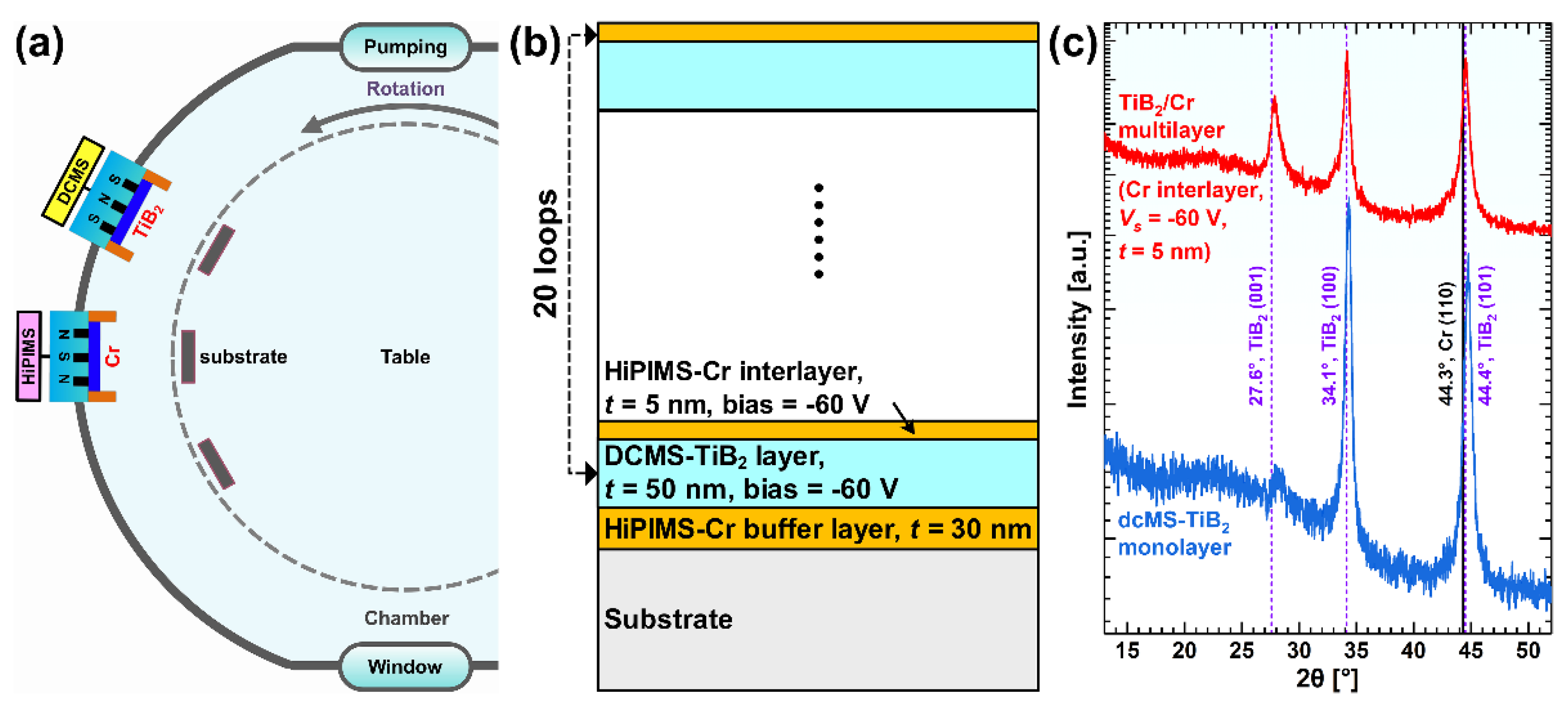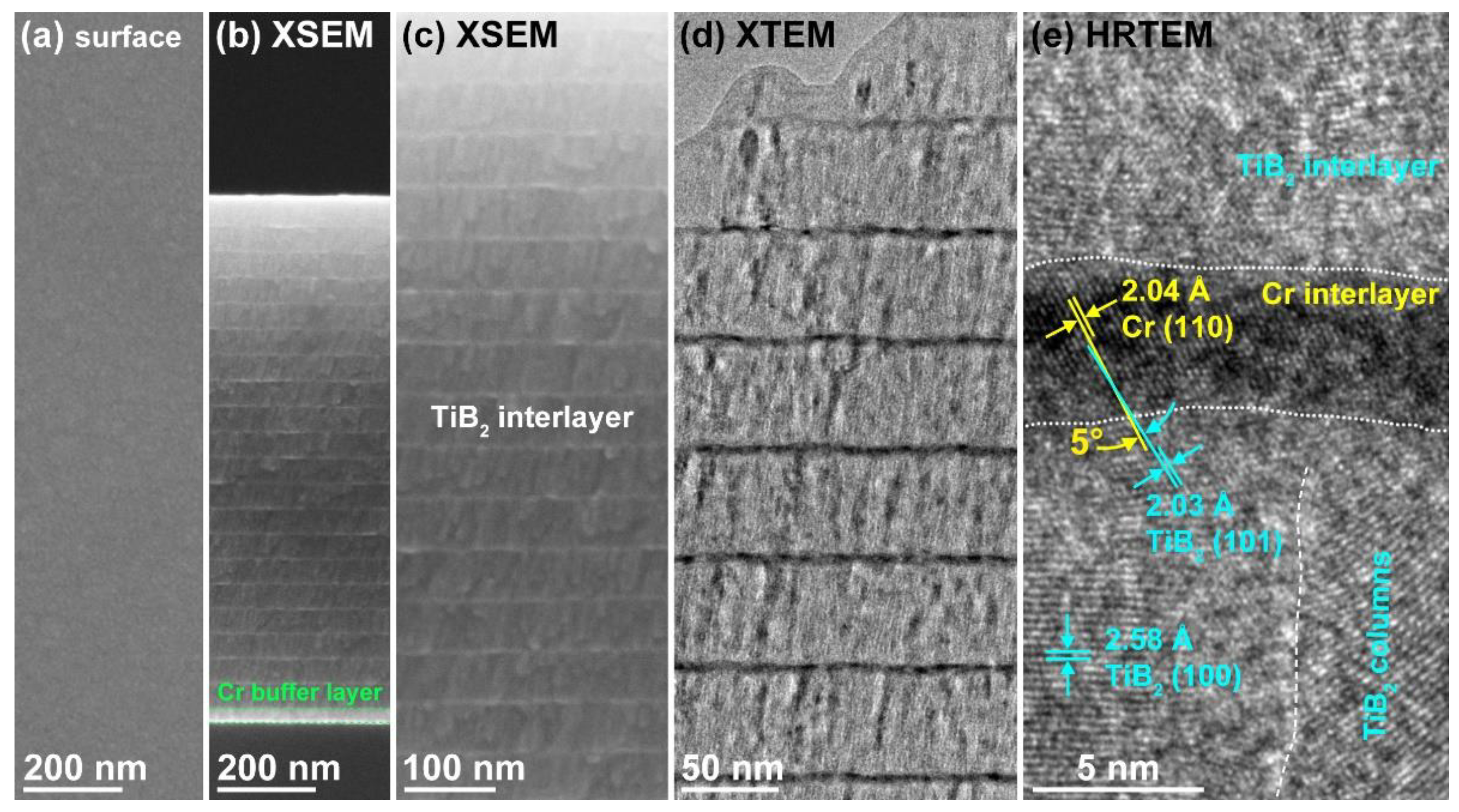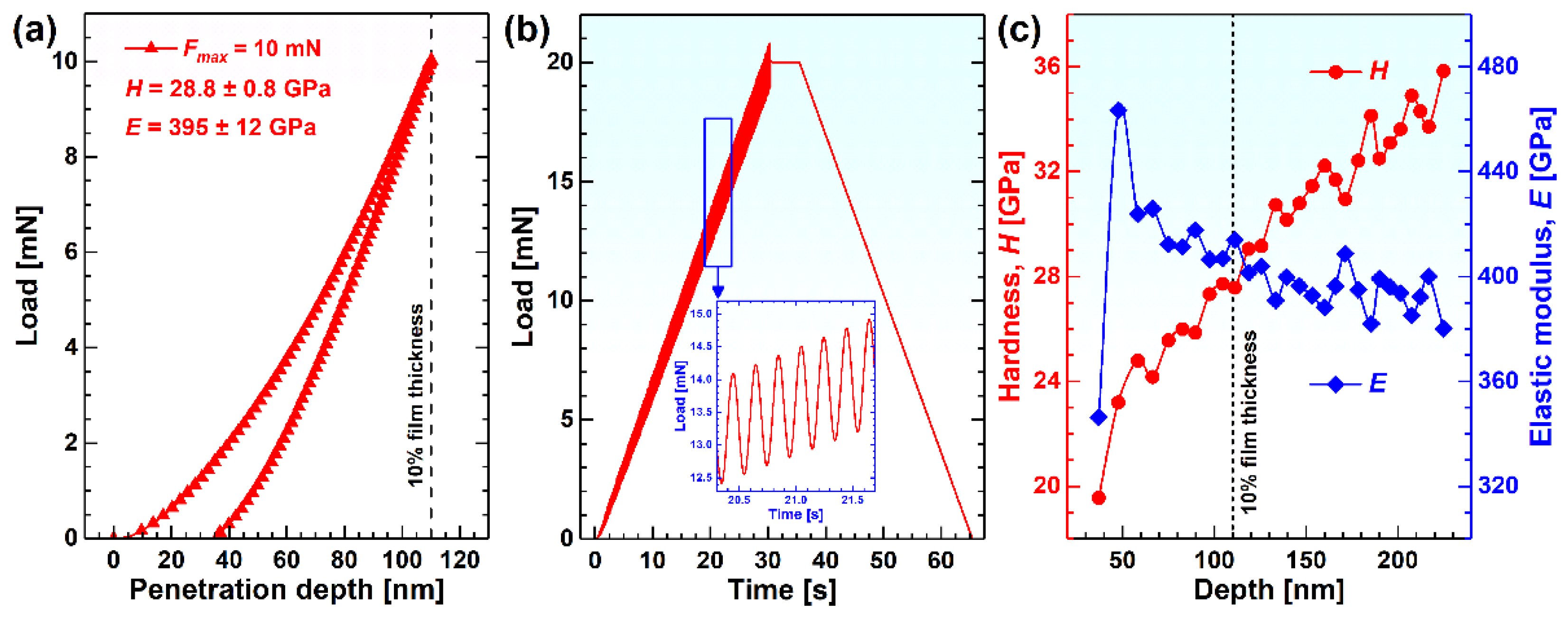A Comparative Investigation of Mechanical Properties of TiB2/Cr Multilayer Film by Indentation
Abstract
:1. Introduction
2. Materials and Methods
3. Results and Discussion
4. Conclusions
Author Contributions
Funding
Institutional Review Board Statement
Informed Consent Statement
Data Availability Statement
Acknowledgments
Conflicts of Interest
References
- Skordaris, G.; Bouzakis, K.-D.; Kotsanis, T.; Charalampous, P.; Bouzakis, E.; Lemmer, O.; Bolz, S. Film thickness effect on mechanical properties and milling performance of nano-structured multilayer PVD coated tools. Surf. Coat. Technol. 2016, 307, 452–460. [Google Scholar] [CrossRef]
- Yang, W.; Ayoub, G.; Salehinia, I.; Mansoor, B.; Zbib, H. Deformation mechanisms in Ti/TiN multilayer under compressive loading. Acta Mater. 2017, 122, 99–108. [Google Scholar] [CrossRef]
- Ghailane, A.; Makha, M.; Larhlimi, H.; Alami, J. Design of hard coatings deposited by HiPIMS and dcMS. Mater. Lett. 2020, 280, 128540. [Google Scholar] [CrossRef]
- Bagdasaryan, A.A.; Pshyk, A.V.; Coy, L.E.; Kempiński, M.; Pogrebnjak, A.D.; Beresnev, V.M.; Jurga, S. Structural and mechanical characterization of (TiZrNbHfTa)N/WN multilayered nitride coatings. Mater. Lett. 2018, 229, 364–367. [Google Scholar] [CrossRef]
- Santaella-González, J.B.; Hernández-Torres, J.; Morales-Hernández, J.; Flores-Ramírez, N.; Ferreira-Palma, C.; Rodríguez-Jiménez, R.C.; García-González, L. Effect of the number of bilayers in Ti/TiN coatings on AISI 316L deposited by sputtering on their hardness, adhesion, and wear. Mater. Lett. 2022, 316, 132037. [Google Scholar] [CrossRef]
- Sun, Y.; Yan, J.; Zhang, S.; Xue, F.; Liu, G.; Li, D. Influence of modulation periods and modulation ratios on the structure and mechanical properties of nanoscale TiAlN/TiB2 multilayers prepared by IBAD. Vacuum 2012, 86, 949–952. [Google Scholar] [CrossRef]
- Li, B.; Ma, X.; Li, W.; Zhai, Q.; Liu, P.; Zhang, K.; Ma, F. Effect of SiC thickness on microstructure and mechanical properties of (AlCrTiZrV) N/SiC nano-multilayers film synthesized by reactive magnetron sputtering. Thin Solid Films 2021, 730, 138724. [Google Scholar] [CrossRef]
- Zuo, B.; Xu, J.; Lu, G.; Ju, H.; Yu, L. Microstructures, mechanical properties and corrosion resistance of TiN/AlN multilayer films. Ceram. Int. 2022, 48, 11629–11635. [Google Scholar] [CrossRef]
- Yang, M.; Liu, Y.; Fan, T.; Zhang, D. Metal-graphene interfaces in epitaxial and bulk systems: A review. Prog. Mater. Sci. 2020, 110, 100652. [Google Scholar] [CrossRef]
- Carpenter, J.S.; Misra, A.; Anderson, P.M. Achieving maximum hardness in semi-coherent multilayer thin films with unequal layer thickness. Acta Mater. 2012, 60, 2625–2636. [Google Scholar] [CrossRef]
- Zhang, Y.; Xue, S.; Li, Q.; Li, J.; Ding, J.; Niu, T.; Su, R.; Wang, H.; Zhang, X. Size dependent strengthening in high strength nanotwinned Al/Ti multilayers. Acta Mater. 2019, 175, 466–476. [Google Scholar] [CrossRef]
- Gurusamy, P.; Prabu, S.B.; Paskaramoorthy, R. Influence of processing temperatures on mechanical properties and microstructure of squeeze cast aluminum alloy composites. Mater. Manuf. Process. 2015, 30, 367–373. [Google Scholar] [CrossRef]
- Dai, W.; Li, X.; Wang, Q. Microstructure and properties of TiB2/Cr multilayered coatings with double periodical structures. Surf. Coat. Technol. 2020, 382, 125150. [Google Scholar]
- Sheng, L.; Xiao, Y.; Jiao, C.; Du, B.; Li, Y.; Wu, Z.; Shao, L. Influence of layer number on microstructure, mechanical properties and wear behavior of the TiN/Ti multilayer coatings fabricated by high-power magnetron sputtering deposition. J. Manuf. Process. 2021, 70, 529–542. [Google Scholar] [CrossRef]
- Wang, C.; Han, J.; Pureza, J.M.; Chung, Y.-W. Structure and mechanical properties of Fe1−xMnx/TiB2 multilayer coatings: Possible role of transformation toughening. Surf. Coat. Technol. 2013, 237, 158–163. [Google Scholar]
- Sun, Y.; Li, D.; Gao, C.; Wang, N.; Yan, J.; Dong, L.; Cao, M.; Deng, X.; Gu, H.; Wan, R. The effect of annealing on hardness, residual stress, and fracture resistance determined by modulation ratios of TiB2/TiAlN multilayers. Surf. Coat. Technol. 2013, 228, S385–S388. [Google Scholar]
- Naeem, M.; Awan, S.; Shafiq, M.; Raza, H.; Iqbal, J.; Díaz-Guillén, J.; Sousa, R.; Jeelani, M.; Abrar, M. Wear and corrosion studies of duplex surface-treated AISI-304 steel by a combination of cathodic cage plasma nitriding and PVD-TiN coating. Ceram. Int. 2022, 48, 21473–21482. [Google Scholar] [CrossRef]
- Chitsaz-Khoyi, L.; Khalil-Allafi, J.; Motallebzadeh, A.; Etminanfar, M. The effect of hydroxyapatite nanoparticles on electrochemical and mechanical performance of TiC/N coating fabricated by plasma electrolytic saturation method. Surf. Coat. Technol. 2020, 394, 125817. [Google Scholar]
- Kim, H.S.; Kang, B.R.; Choi, S.M. Fabrication and characteristics of a HfC/TiC multilayer coating by a vacuum plasma spray process to protect C/C composites against oxidation. Corros. Sci. 2021, 178, 109068. [Google Scholar] [CrossRef]
- Wang, C.; Pureza, J.M.; Yang, Y.; Chung, Y.-W. Investigation of hardness and fracture toughness properties of Fe/VC multilayer coatings with coherent interfaces. Surf. Coat. Technol. 2016, 288, 179–184. [Google Scholar]
- Dong, L.; Li, D.; Zhang, S.; Yan, J.; Liu, M.; Gao, C.; Wang, N.; Liu, G.; Gu, H.; Wan, R. Microstructure and mechanical properties of as-deposited and annealed TiB2/BN superlattice coatings. Thin Solid Films 2012, 520, 5328–5332. [Google Scholar] [CrossRef]
- He, X.; Dong, L.; Wu, J.; Li, D. The influence of varied modulation ratios on crystallization and mechanical properties of nanoscale TiB2/Al2O3 multilayers. Surf. Coat. Technol. 2019, 365, 65–69. [Google Scholar] [CrossRef]
- Rao, J.; Cruz, R.; Lawson, K.; Nicholls, J. Sputtered DLC-TiB2 multilayer films for tribological applications. Diamond Relat. Mater. 2005, 14, 1805–1809. [Google Scholar] [CrossRef]
- Wu, Z.; Ye, R.; Bakhit, B.; Petrov, I.; Hultman, L.; Greczynski, G. Improving oxidation and wear resistance of TiB2 films by nano-multilayering with Cr. Surf. Coat. Technol. 2022, 436, 128337. [Google Scholar] [CrossRef]
- Mattucci, M.; Cherubin, I.; Changizian, P.; Skippon, T.; Daymond, M. Indentation size effect, geometrically necessary dislocations and pile-up effects in hardness testing of irradiated nickel. Acta Mater. 2021, 207, 116702. [Google Scholar] [CrossRef]
- Ferreira, F.; Serra, R.; Oliveira, J.C.; Cavaleiro, A. Effect of peak target power on the properties of Cr thin films sputtered by HiPIMS in deep oscillation magnetron sputtering (DOMS) mode. Surf. Coat. Technol. 2014, 258, 249–256. [Google Scholar] [CrossRef]
- Cho, K.-H.; Kim, Y. Elastic modulus measurement of multilayer metallic thin films. J. Mater. Res. 1999, 14, 1996–2001. [Google Scholar] [CrossRef]




| Process Parameters | Values |
|---|---|
| Cr-HiPIMS power [kW] | 1.5 (200 Hz, 50 µs pulse length, duty cycle 1%) |
| TiB2-dcMS power [kW] | 2.0 |
| Deposition pressure [Pa] | 0.4 |
| Deposition temperature [°C] | 500 |
| Bias [V] | −60 (synchronized to the Cr-HiPIMS pulse, offset time 40 μs, pulse length 100 μs) |
| Samples | Cr Layer Thickness [nm] | Cr Substrate Bias [V] | B100 [°] | Average Grain Sizes of TiB2 [nm] |
|---|---|---|---|---|
| TiB2 monolayer | 0 | - | 0.45 | 15.7 |
| TiB2/Cr multilayer | 5 | −60 | 0.46 | 15.1 |
Publisher’s Note: MDPI stays neutral with regard to jurisdictional claims in published maps and institutional affiliations. |
© 2022 by the authors. Licensee MDPI, Basel, Switzerland. This article is an open access article distributed under the terms and conditions of the Creative Commons Attribution (CC BY) license (https://creativecommons.org/licenses/by/4.0/).
Share and Cite
Chen, S.; Wu, Z.; Wang, Q. A Comparative Investigation of Mechanical Properties of TiB2/Cr Multilayer Film by Indentation. Magnetochemistry 2022, 8, 148. https://doi.org/10.3390/magnetochemistry8110148
Chen S, Wu Z, Wang Q. A Comparative Investigation of Mechanical Properties of TiB2/Cr Multilayer Film by Indentation. Magnetochemistry. 2022; 8(11):148. https://doi.org/10.3390/magnetochemistry8110148
Chicago/Turabian StyleChen, Simeng, Zhengtao Wu, and Qimin Wang. 2022. "A Comparative Investigation of Mechanical Properties of TiB2/Cr Multilayer Film by Indentation" Magnetochemistry 8, no. 11: 148. https://doi.org/10.3390/magnetochemistry8110148
APA StyleChen, S., Wu, Z., & Wang, Q. (2022). A Comparative Investigation of Mechanical Properties of TiB2/Cr Multilayer Film by Indentation. Magnetochemistry, 8(11), 148. https://doi.org/10.3390/magnetochemistry8110148







